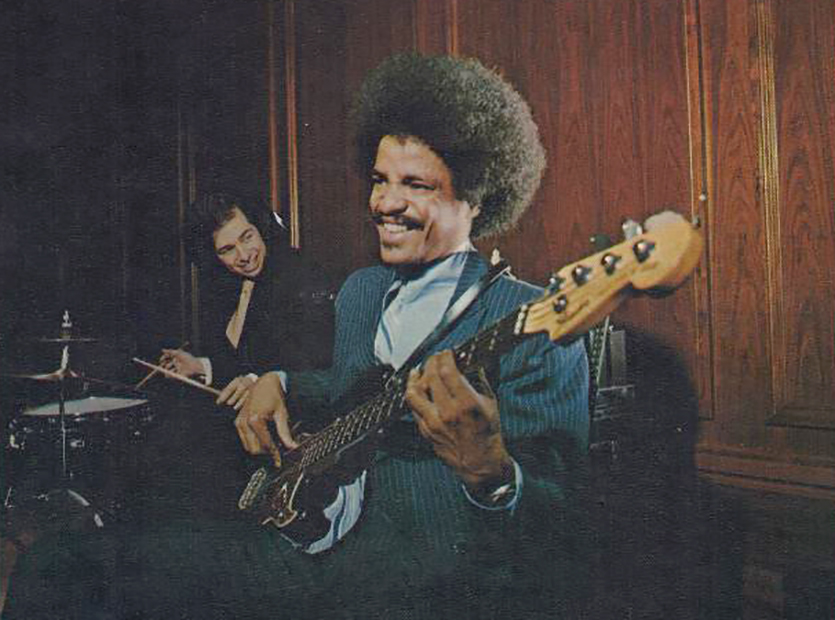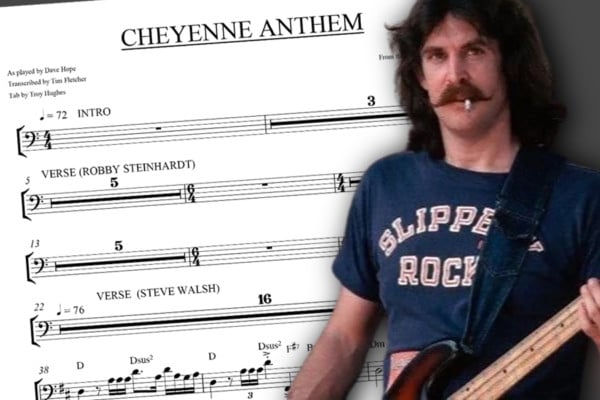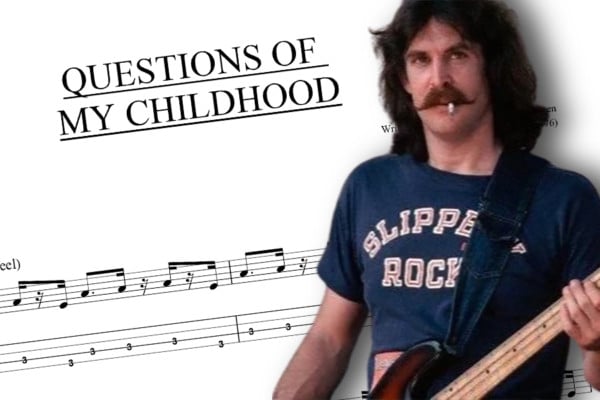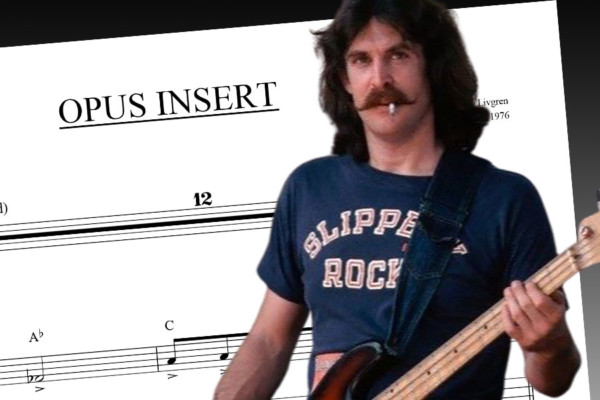Bass Transcription: Phil Upchurch’s Bass Line on “Misty” by Donny Hathaway

Phil Upchurch has played on over two hundred albums, and is highly regarded for his jazz, pop and funk guitar work with artists such as George Benson, Chaka Khan, Quincy Jones, David Sanborn, and Michael Jackson. He is perhaps less well-known for his bass playing, but he has contributed some excellent work to albums by Grover Washington, John Lee Hooker, Chuck Berry, Dizzy Gillespie, Stan Getz, and many others.
Upchurch was born on July 19th, 1941, in Chicago, and as a child he played the piano, giving his first recital at the age of eight. He also played the ukulele, and, as a teenager – assuming that the extra two strings wouldn’t provide too much of a challenge – he took up the guitar. He made enough progress to make his recording debut with VeeJay records around 1956 and turned pro shortly afterward. His ability in the studio was soon recognized, and he played and recorded with R & B artists including The Dells, The Spaniels and The Kool Gents, and blues artists such as Jimmy Reed and B.B King. In 1960, Upchurch was offered his first bass gig with Otis Rush but had to go and buy a bass to get the job. This initial connection with the bass gave yet another outlet to showcase his musical ability during his career.
By the age of twenty, he was also leading his own band, The Phil Upchurch Combo, and had a million-selling hit with “You Can’t Sit Down” in 1961. Phil’s bass line from this track was a big influence on John Paul Jones of Led Zeppelin, who recalled that “the first record that really turned me on to rock bass guitar was “You Can’t Sit Down” by Upchurch, which has an incredible bass solo and was a really good record as well”. Upchurch continued to lead his own projects between sessions and his live work, and to date has released twenty-seven albums under his own name.
In 1967, he returned from a two-year stint serving as a radio operator with the US Army, and renewed his session career – but this now included recordings for jazz artists such as Dizzy Gillespie and Stan Getz, in addition to the blues and R & B that had made up most of his work. Upchurch also began a collaboration with The Staple Singers around this time, and he was also employed as house guitarist at the legendary Chicago label Chess.
In the late 1960s, Upchurch began to work with fellow Chicago native Curtis Mayfield, playing on his first solo album Curtis in 1970. With Mayfield as the producer, Upchurch also played on the soundtracks to the films “Superfly” in 1972, “Claudine” with Gladys Knight and the Pips in 1974, “Let’s Do It Again” with The Staple Singers in 1975, and “Sparkle” with Aretha Franklin in 1976. This connection with Curtis Mayfield may have been the catalyst for his work with Donny Hathaway. Hathaway had worked as Mayfield’s musical director, and as a songwriter, arranger, session musician, and producer for his Curtom label. Like Upchurch, Hathaway had worked on some of The Staple Singers’ projects, and when he wanted to play more regularly, he called Upchurch and asked him to organize a band for live gigs – christened “The Co-Ops” – and they performed regularly around Chicago.
Upchurch invited Hathaway to play piano on his 1969 albums Upchurch and The Way I Feel, and when Hathaway was signed by the Atco label, he returned the favor by asking Upchurch to play on his debut album Everything is Everything in 1970. Upchurch contributed guitar and bass to the album – although Louis Satterfield and Marshall Hawkins also play superbly – and collaborated on the composition of the title track. Upchurch was to play on all of Hathaway’s studio albums, and the acclaimed 1972 album Live, but after Everything is Everything this was mainly as a guitarist, as the bass role was usually taken by others, including Chuck Rainey, Willie Weeks and Stanley Clarke.
In 1974 Upchurch began to work with jazz guitarist George Benson, contributing material and playing guitar and bass on his albums for the next seven years. Upchurch moved to Los Angeles in 1978 and the sessions began to include collaborations with more mainstream pop artists such as Chaka Khan and Natalie Cole. He also played on such varied works as Michael Jackson’s Off the Wall in 1979 and the Sesame Street album In Harmony in 1980. He continues to record and tour with a wide range of artists and recording albums by his own ensembles.
“Misty”
This jazz standard was composed in 1954 by Johnny Burke and Errol Garner and has been covered many times by both jazz and pop artists. Hathaway’s version has perhaps a more gospel sensibility than other versions, using a 12/8 feel with a semiquaver shuffle, and lowering the tempo to a very stately 43 bpm.
The bass line is quite complex in places, and Upchurch includes a wide range of ideas. For example;
The use of chromaticism. Upchurch’s use of consecutive semitones is quite reminiscent of James Jamerson’s work and this could be influenced by both his and Upchurch’s roots in jazz. For example; bar 2 (to approach the inversion of the F chord), bar 13 (used to approach the notes of the B diminished triad), and bars 20, 25-6 and 26-7 (to approach the root of the next chord).
Octave double stops. In the last two beats of bar 17, Upchurch firstly holds the higher D note and then introduces another an octave below, then reverses the idea using a C#.
The use of semiquaver triplets. examples in bars 2, 9, 13, 23, 27, 29, 30 and 31.
The inclusion of wide intervals to open strings. These happen in several places (bars 8, 9, 11, 34) and help to create a more varied intervallic landscape than simply using pitches within reach in any one position.
The use of non-standard note choices. For example, the use of D and C# over the C+ chord in bar 10 create a clash with the keyboard and horns, but gradually the dissonance is resolved into the next bar.
The use of repeating phrases. There are some more rhythmically dense, repeating motifs in bars 29, where a semiquaver triplet is introduced over the second quaver of the beat, and in 33 where the phrase varies to match the chord changes. The use of repetition adds tension and impact.
The range of ideas used by Upchurch helps to keep the bass line engaging and interesting, and although it becomes quite busy at times, the bass line doesn’t seem to diminish the impact of the main vocal. Upchurch’s tone is broad and deep, and perhaps this helps.
Download the transcription and follow along with the track:



About time this killer bassist and jazz guitarist got some props. He has been a favorite of mine for years. Check out his playing on Little Milton’s Poor Man’s Song. If you can find an old gospel album by the Salem Travelers there are some fine examples of just how good he is. He’s in a class with Jamerson and Kaye.
Hi Sandy. Thanks for the tips on finding more of Phil Upchurch’s playing – he’d played on so many great recordings, and with so many great artists that it was tricky to choose one track. I partly chose his work with Donny Hathaway as it overlapped with Jamerson’s work with Marvin Gaye which bears some comparison. It might be possible that Phil Upchurch would have had more kudos as a bassist if he had worked consistently for a more soul or R&B oriented label, and perhaps wasn’t such a great guitarist!
Any idea which Salem Travellers albums have Mr. Upchurch?
Hi Marc. I’m sorry, but I can’t answer that. Maybe ask on the No Treble Facebook group – lots of very knowledgeable people on there.